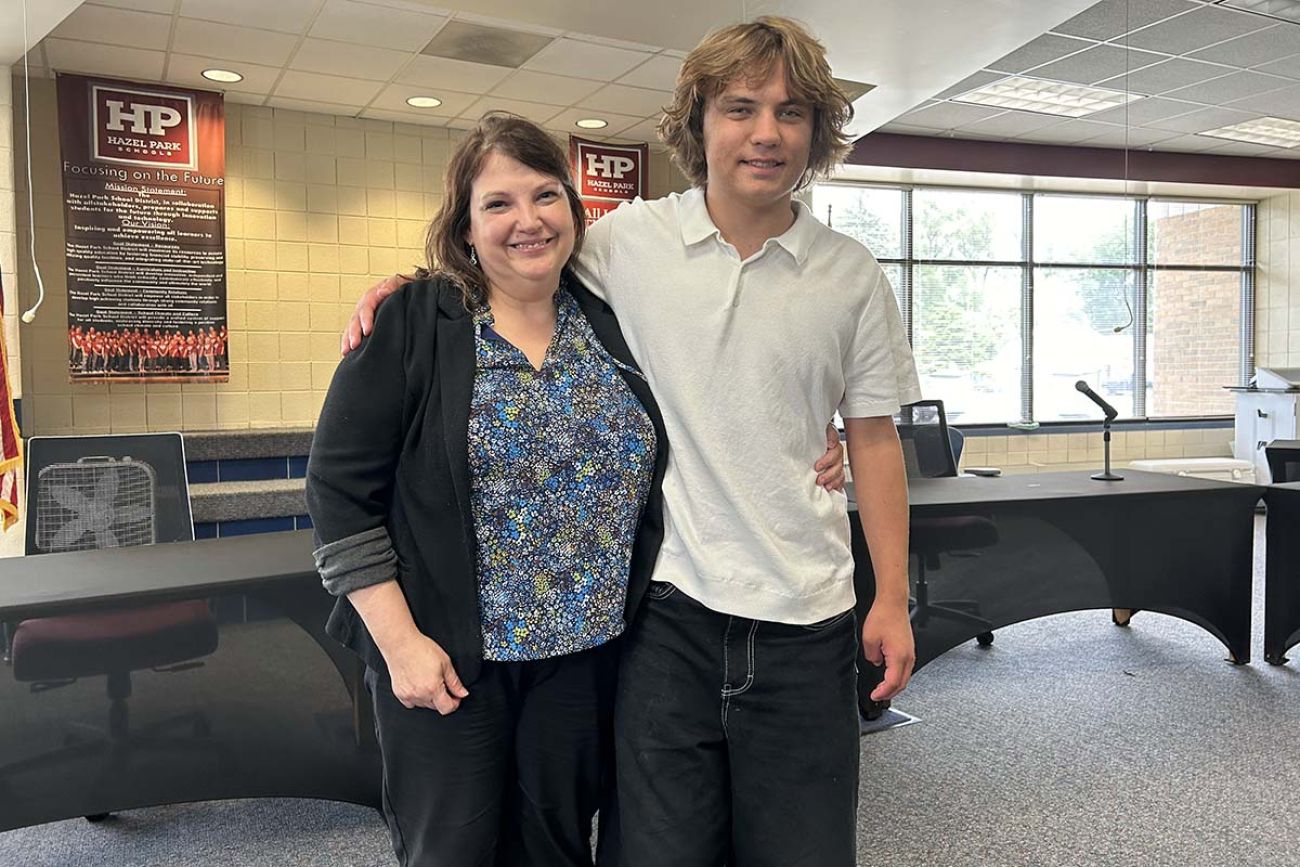Michigan failed to curb ‘seclusion and restraint.’ One school tries again

- Michigan schools still secluding and restraining students with disabilities at high rates despite 2016 law
- One school district is beginning to police itself, and advocates say others should follow
- State lawmakers, officials acknowledge need for more reform
HAZEL PARK — As Michigan schools continue to seclude and restrain students with disabilities at high rates, despite a state law designed to limit the controversial practice, one local school district is beginning to police itself.
The Hazel Park school board last week approved a plan that aims to curb seclusion and restraint in the district’s special education school by 30%, boosting training and oversight as part of what an advocate called a "pretty unique" approach to techniques the state had tried — but so far failed — to curb.
“Every school that is using seclusion and restraint should have a plan like this in place," said Cassie Atallah, co-leader and co-founder of the Michigan Advocates to End Seclusion and Restraint. "This is simply complying with the law."
Michigan lawmakers approved new limits in 2016 that advocates hoped would lead to a sea change in how school districts and educators approach seclusion and restraint, practices defenders say are typically used as measures of last resort to calm or otherwise contain students in dangerous situations.
Current state policy, based on the law, makes clear schools should only consider physically restraining a student or confining them to a room away from others in emergency situations where a student is at risk of harming themselves or others.
Related:
- Michigan students fell behind during COVID. Their recovery lags other states
- Michigan school funding bump varies by district. See how much yours will get
- Michigan touts 'free pre-K for all.' It's more complicated than that
But state data shows the techniques are still widely used in Michigan despite the law, prompting legislators to promise a “thorough examination” amid growing calls for additional reform.
Michigan schools secluded students with disabilities 11,910 times and restrained them 9,076 times in the 2022-2023 academic year, according to state data. The year before, educators secluded 9,166 students and restrained 7,615.
That’s little change from the first year the data was collected, in 2017-2018, when school districts reported secluding students with disabilities 9,055 times and using restraint 9,231 times.
“It’s still way too high. It's still in many areas the go-to strategy for problematic behaviors,” said former Lt. Gov. Brian Calley, who led the 2016 effort to end non-emergency use of what he had called “barbaric and inhumane” practices.
Students with disabilities are involved in the vast majority of instances of seclusion and restraint in Michigan. Advocates for ending the techniques contend they are traumatic, dangerous and counterproductive.
It makes kids feel “more like criminals than students,” said Bennett Solomond, a former student at Edison School in Hazel Park, an 85-student program for students with emotional and behavioral disabilities that enrolls children from across Oakland County for special education services and support.
Edison was “terrifying,” Solomond, who is now a high school senior in Pennsylvania, told school board members in a recent public meeting. He alleged he was repeatedly secluded and restrained in non-emergency situations.
“What is happening there (has) nothing to do with emergencies,” he said, “so please act.”
Solomond’s mother, Melissa Freel, told board members her son “looked and acted like a kid who had PTSD, he trembled and shook when he walked into a public education school because it simply smelled like Edison.”
A new approach
The new plan adopted last week by the Hazel Park school board aims to reduce seclusion and restraint by 30% for all elementary students, male students and students with emotional impairments.
Hazel Park will develop an oversight team charged with strategies to reduce seclusion and restraint, regularly review student data, train staff members and pilot new equipment.
Superintendent Amy Kruppe told Bridge Michigan the district has been using a trauma-informed training program for years but nonetheless had increased the use of physical restraints.
“We want our staff to have as many strategies to de-escalate behavior as possible,” Kruppe said.
Hazel Park had secluded students with disabilities 330 times and restrained them 298 times in the first half of the 2023-2024 school year, according to the most recent data available.
Statewide, Michigan districts reported 5,438 seclusions and 4,416 restraints in the first half of last year.
Experts told Bridge districts should provide strong support to students who may have challenging behaviors before they are ever in crisis that warrants seclusion or restraint.
Calley said he would like to see each school have a board-certified behavior analyst involved so that school employees understand the reason behind a child’s behavior.
Hazel Park Schools has hired two board-certified behavior analysts in the hopes they can help with de-escalation strategies and individualizing behavior intervention plans, Kruppe told Bridge.
Some states have banned seclusion
Michigan legislators attempted to curb seclusion and restraint eight years ago, writing into state law that seclusion and restraint should not be used as a form of punishment — and only in cases of emergency.
As described in a 2017 policy implementation guide, schools should not seclude students “any longer than necessary,” generally up to 15 minutes for an elementary student and 20 minutes for older students. Students should only be restrained for more than 10 minutes if additional support staff is brought in.
But practically speaking, experts say there aren’t any state penalties for school districts that use seclusion or restraint in non-emergency situations.
There is a clause in the broader state education law that says violations could be considered a misdemeanor, but it’s rarely if ever been used against schools that don’t comply, said Bob Lusk, a lawyer who has represented both school districts and parents of students in special education programs.
“There’s no one to tap schools on the shoulder to say, ‘This isn’t OK, what are you going to do about it?,” added Atallah, of the Michigan Advocates to End Seclusion and Restraint.
A handful of other states have taken more aggressive steps: In Georgia and Hawaii, seclusion is forbidden. In Florida, schools are not allowed to seclude students with disabilities. Earlier this year, Colorado lawmakers considered a bill to end seclusion, but it did not pass.
On the federal level, 105 members of Congress have backed a 2023 bill to prohibit seclusion and limit restraint in schools that receive federal funding. But the legislation has not advanced or become law.
The need for additional reform is clear, said Calley, the former lieutenant governor.
“The debate is settled, as far as I'm concerned, that this is a major and urgent problem that is begging for a solution,” he said.
State officials call for change
The Michigan Department of Education has had “preliminary discussion with legislators and stakeholders about consideration of changes” to the law, MDE spokesperson Bob Wheaton said in an email.
State Superintendent Michael Rice “urges” the Legislature to “review the current statute, hold hearings, and reflect on what changes would better address the needs of students” and improve data collection, Wheaton added.
Earlier this year, Republican State Board of Education member Nikki Snyder tried to get colleagues to approve a resolution urging the legislature to enact penalties for not complying with the law, but the measure failed.
Gov. Gretchen Whitmer and Senate Majority Leader Winnie Brinks, D-Grand Rapids, said back in 2022 that more work should be done on seclusion and restraints.
“We maintain that this is a serious issue that deserves thorough examination,” spokesperson Rosie Jones told Bridge last week. “Any solutions will be informed by the real-life experiences of students, their parents, educators, health professionals and other stakeholders.”
Amber McCann, a spokesperson for House Speaker Joe Tate, D-Detroit, said no specific legislation has been introduced but “there is ongoing discussion around possible changes to the state’s current law.”
A ‘terrible cycle’
Parents and advocates told Bridge restraining or secluding a student can be harmful for the student and the person restraining them. Research suggests that as well.
“It’s a terrible cycle,” said Calley, the former lieutenant governor. “This is not hyperbole, it is destroying kids’ lives. It is stealing away their future.”
Seclusion and restraint should be a turning point for educators and students, but that’s often not the case because “nobody really knows what to do except for restrain tomorrow, and restrain the next day and restrain the next day,” he said.
In Hazel Park, Kruppe said she thinks staff turnover leads to a reliance on seclusion and restraint because new hires “don’t have as long standing skills in working with this behavior.”
“So you're constantly having to build those skills up again,” she said.
As part of its new plan to curb the practice, Hazel Park is working with Ukeru, a division of a Virginia-based behavioral health provider that trains school professionals on trauma-informed practices and provides equipment.
In Kalamazoo, eight months after the full staff at WoodsEdge Learning Center underwent the training, there was an 88% reduction in restraints, 98% reduction in seclusion and 79% reduction in staff injury, according to Ukeru.
Some educators believe seclusion and restraint is necessary in situations that are or could turn dangerous, said Jason Ervin, a behavior support specialist at WoodsEdge.
They hope the techniques can end incidents sooner and “prevent injury for staff or even other students,” Ervin said. “But in a lot of cases, that’s not the case.”
Heather Martinez, CEO of Boldli, formerly the Detroit Institute for Children, which provides therapists and educators to schools, said schools should provide positive behavior interventions support (PBIS) for all students and specific behavior intervention plans for some students.
Staff need training on verbal and nonverbal de-escalation techniques to help students in crisis so that seclusions or restraints are rare, she added.
But how much effort schools put into that PBIS process varies, said Lusk, the attorney who has worked with schools and students.
“I would like to see school districts become more aggressive at behavioral interventions, particularly when students are young,” Lusk said.
“If you don't deal with these issues when children are younger, (it’s) much more difficult to deal with when the children are older, stronger and more strong-willed.”
Michigan Education Watch
Michigan Education Watch is made possible by generous financial support from:
Subscribe to Michigan Health Watch
See what new members are saying about why they donated to Bridge Michigan:
- “In order for this information to be accurate and unbiased it must be underwritten by its readers, not by special interests.” - Larry S.
- “Not many other media sources report on the topics Bridge does.” - Susan B.
- “Your journalism is outstanding and rare these days.” - Mark S.
If you want to ensure the future of nonpartisan, nonprofit Michigan journalism, please become a member today. You, too, will be asked why you donated and maybe we'll feature your quote next time!





